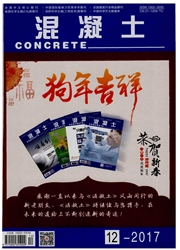

 中文摘要:
中文摘要:
以福建漳(州)永(安)高速公路官田隧道通风竖井为工程依托,针对该竖井径深比较小的特点,对传统的钻机反井正向扩大法进行了工艺改进,使用空气潜孔锤代替传统反井钻机钻头,合理控制钻压并使用减压式钻进,有效地减小了导孔的倾斜度,并减小了钻头的磨损,实现了竖井的快速施工,形成一套用于径深比较小(小于1.3%)的深竖井反井施工技术;同时引入自动监测和无线传输技术对硬质岩深竖井的水平围岩压力进行测试,测试断面埋深在180-320 m,实测围岩压力为0.01-0.03 MPa,是JTG/T D70—2010《公路隧道设计细则》中秦巴列维奇公式计算值的24%-46%,而且跟埋深无直接关系;建议今后在竖井设计中对围岩压力取值适当优化,并通过更多的试验样本和工程实践进一步完善。
 英文摘要:
英文摘要:
The diameter-depth ratio of ventilation vertical shaft of Guantian Tunnel on Zhangzhou-Yongan Expressway in Fujian is small. As a result,the conventional raise-boring method is improved; the conventional drill bit of raise-boring drill is replaced by air DTH hammer; and then the pressure-reduce-typed boring mode is adopted. The gradient of guiding hole is reduced; the drill bit abrasion is reduced; rapid construction of vertical shaft is achieved; and a series of raise-boring methods( with diameter-depth ratio less then 1. 3%) for hard-rock deep vertical shaft is obtained.Meanwhile,the horizontal pressure of surrounding rock of hard-rock deep vertical shaft is measured by means of automatic monitoring technology and wireless transmission technology. The measured results( 0. 01- 0. 03 MPa) are24%- 46% of the values in related criteria and are independent of depth. The authors suggest that the surrounding rock pressure should be further improved.
 同期刊论文项目
同期刊论文项目
 同项目期刊论文
同项目期刊论文
 期刊信息
期刊信息
